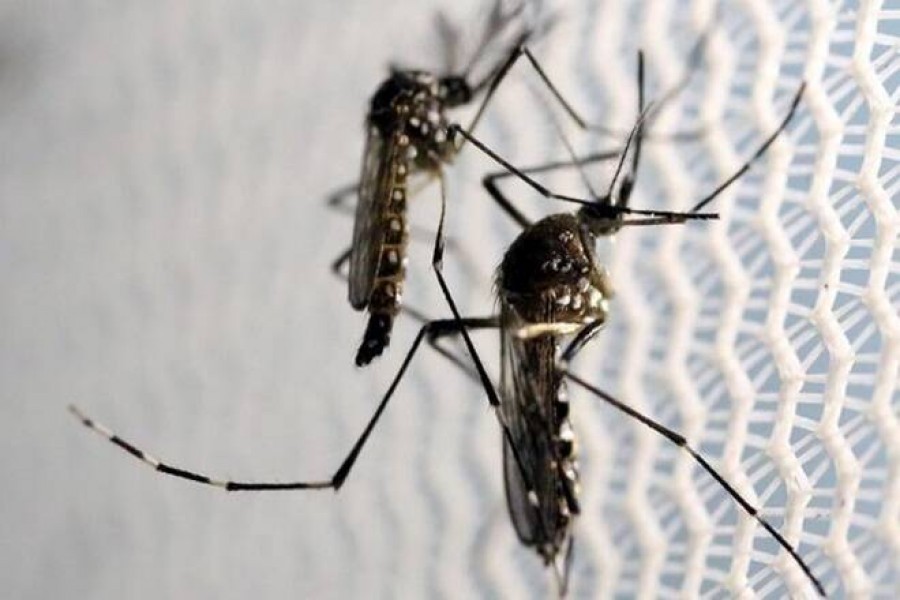Amid the worldwide rampage of the Covid-19 pandemic in the last 2021, the unremitting surge in the dengue-positive cases and fatalities in Bangladesh remained out of the general appraisal. Compared to the global ferocity of corona pandemic times, the country's vulnerable position was no less distressing; it turned out to be so due to the nearly simultaneous onslaughts of the two often-fatal diseases. The Covid-19 outbreak started in the country in early March in 2020. Dengue's onslaught, presumed wiped out with negligible numbers of cases and deaths, came to the surface a little earlier --- in 2019. Few had thought that the scourge actually remained dormant after it wrought havoc with several thousand city-based people. Bangladesh recorded its highest dengue deaths at 156 in 2019. The fateful year also saw 1,01,354 dengue-positive cases. The year of 2000 witnessed fatalities at 93.
The country saw a total of 105 dengue-related deaths in 2021. The fever was transmitted to a total of 5,551 persons by the Aedes Aegypti mosquito in 2020. The figure jumped to 28,429 in 2021. Due to it being out of proper notice of the general people and the health authorities, the surge in the infected patients and fatalities continued in silence.
Thanks to dengue's localised nature and Covid-19's global spread, vaccination uproars, lockdowns and stringent health guidelines the media coverage of Bangladesh-centred dengue remained pale beside the screaming headlines about Covid-19. Nonetheless, it kept affecting Bangladesh in terms of the country's health sector. In the earlier cases, the country's labour productivity had to bear the brunt of this debilitating vector-borne and communicable disease. This time, romping in tandem with the Covid-19 pandemic, dengue may no longer remain a seasonal and common disease. That the country, being part of global trade and business community, cannot afford to play the role of a silent watcher is implied. There is a hard truth. The high-fever disease coupled with scores of health complications carries the potential for leaving a dampening impact on the sectors dependent on physical wellbeing of all levels of the labour force from the blue collar RMG hands upwards --- mid-level to top-level white collar executives. There are few industries in Bangladesh which do not need manual labourers at one or another stage. The country is still quite far from being fully automated or digitised. Even notwithstanding being a prime requirement, many mid-level industries cannot afford to have assembly lines in different stages of production. It leads to the inevitable dependence on manual labour, which has to be free of all kinds of energy-sapping ailments.
With the country's health sector and the trade and industrial stakeholders now riveted to Covid-19, the ongoing dengue scourge is being glaringly given a short shrift. Policymakers, exporters, especially those of readymade garments (RMG) and non-traditional items have reasons to draw the attention of the health authorities to the imperative of checking the surge of the veritably endemic dengue.
Thanks to its menacing recurrence, with feared impacts on all sectors of the nation including also education, office work etc., dengue outbreak cannot be underestimateed. It may not be a pandemic with a global grasp, but due to its being endemic to the country, Bangladesh alone may have to deal with the scourge in this time of Covid-19 and its variant Omicron. Unlike in the case of the raging pandemic, the World Health Organisation (WHO) may not afford to make extra time to focus on the Bangladesh dengue. Against this backdrop, the country itself has to chart out anti-dengue measures. At the initial stage of a dengue patient, physicians suggest fever remitting analgesics. There are a few strains of dengue fever which cause severe pain to bone joints, earning for it the name of 'bone crushing'. It is sad to note that despite the prevalence of the dengue vectors and the resultant physical ordeals, including death, a highly specialised and modern hospital has yet to be in place in Bangladesh.
The Directorate General of Health Services (DGHS) has recently set up six dengue-dedicated hospitals in the Dhaka city and the neighbourhood areas. Those include Sir Salimullah Medical College Hospital, Shaheed Ahsan Ullah Master General Hospital at Tongi in Gazipur, Railway General Hospital at Kamalapur, Dhaka, the 20-bed Aminbazar Govt Hospital and the 31-bed Kamrangir Char Hospital. It's nice to hear about the hospitals. Apart from them, many private hospitals in the country's cities have facilities for impromptu dengue wings. Dengue, in fact, is seasonal disease. According to reports from many sources, due to its being mainly a Dhaka-based endemic disease, dengue patients nowadays are admitted to hospitals almost round the year. Common dengue is curable in a few days. What the patients need is long rest. But what causes panic to the patients, doctors and the attendants is the hemorrhagic dengue fever. It attacks people with many symptoms like rash, skin ruptures, inner and outer bleeding etc. Even doctors term it a dreadful type of dengue.
Against a backdrop of easy treatment of dengue and the increasing rate of cures, the dearth of highly specialised physicians remains an enigma. Given the formidable rise in dengue infections and deaths, Bangladesh should have dozens of dengue experts and care-givers. Dengue spares none, affecting both the rich and the poor with equal ferocity. The affluent class can afford treatment abroad. The underprivileged has only one option: taking cheap treatment at public hospitals and giving themselves in to fate. The prolonged assault of dengue leads to economic hardship, especially job losses. It's because the fever saps almost all the energy and vitality of a person.
What prompts the dengue outbreak is the absence of awareness campaigns. They comprise only a few words. Keep your homestead and neighbourhood free of accumulated clean rainwater. It is where the dreadful Aedes Aegypti mosquito lays eggs. The nightmarish spread of the dengue vector begins from these places. The city corporations have to take a large share of the failures to fight dengue.


